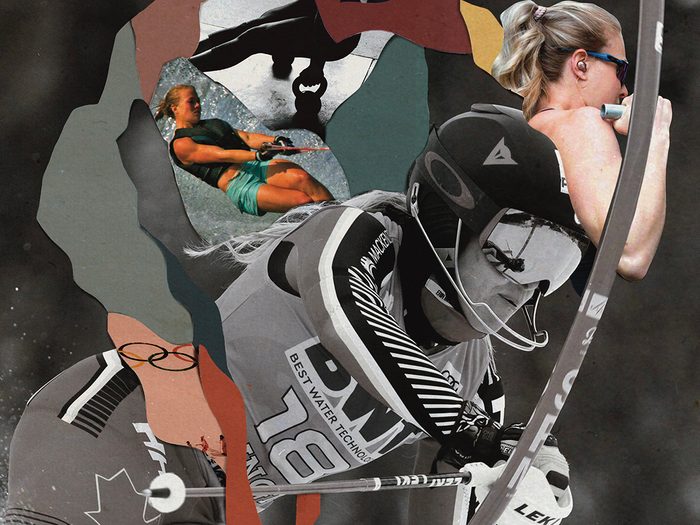Alpine Skier Erin Mielzynski: “I Was Just Trying To Be Perfect”

Alpine skier and host of Unspoken Bravery podcast, Erin Mielzynski shares this candid essay about her experience with body image issues in elite sports.
People started commenting on my body pretty early. I was a competitive water skier starting at age six. We’d go to the fair and my sister, who also water skied, would volunteer for the “guess your weight” booth. We thought it was so funny that, as a muscly athlete in a deceivingly small frame, people’s guesses would be completely off.
By Grade 8, kids started commenting on how big my arms were getting from water skiing. It didn’t stop me from wanting to get stronger and compete, especially because in the water skiing world, I was completely normal. But as a kid, it was hard. I started wearing long-sleeve shirts, hiding my arms from view, and avoided putting my hair up in a ponytail in front of people because my muscles would flex.
As an alpine skier, I’m now in a sport that isn’t judged—the best time wins—but I still hear comments about women’s bodies from the spectators. I’ve heard bodies compared to the shape of a cell phone, presumably because they’re flat-chested, square- shaped and stocky. Some athletes don’t want to wear the padding, which protects us from injury, because it makes them look bigger. I’ve had those moments, too. As athletes, we’re chasing perfection and that can extend to how we look.
When I transitioned from water skiing to alpine, I started training in a gym. I had never lifted weights or done squats before, and I felt behind the rest of my team. I wanted to improve as quickly as possible, so I studied the athletes around me and diligently followed the provided diet plan. When the team’s nutritionist told me to eat 10 almonds as a snack and eat lean chicken with no sauce, that’s literally how I ate.
At 19, my body composition results—meaning the battery of tests measuring everything from muscle mass to body fat percentage, to inform our training—said that my body fat was too low. I was sent to Calgary where I met with the person who ultimately helped me develop a healthy body image: sports physiologist Matt Jordan. He’s an amazing teacher and he taught me to start asking why: Why am I being told to eat less oil or drink only skim milk?
Matt helped me understand that skiers need more than muscle. I need weight to get down the hill and fat to keep me healthy throughout the year and protect me if I fall.
I’ve had coaches make suggestions that should only come from a sports physiologist, nutritionist or doctor. One coach told me that based on my body composition results, I looked like a prepubescent boy, and that with those numbers, I couldn’t be a contributing woman in society. I think what he meant is that it’s not sustainable to stay this way. He was trying to scare me into changing. Another told me and my teammates to go biking to burn calories before having lunch and frequently made comments about my body. That same coach questioned why I wasn’t skiing well at the time, since I had the perfect body for alpine racing. I remember thinking, “What is the perfect body in skiing?” I saw people of all different heights and sizes making it to the podium, but he had this one, narrow idea of what an athlete should look like.
I don’t look at my body composition data anymore. I now ask my coach just to tell me whether I’ve improved or if there’s a concern, but I don’t need to know the specific numbers because I trust him completely. I’m also careful with how I talk about my body, diet and training because I know that I am setting an example for younger skiers. For instance, I no longer call body composition tests “the fat test” as we did when I was younger.
It really bothers me that we define how hard someone is working by how they look. I built my body for skiing to get down the hill fast. But beyond that, I’m a person. When viewers watch athletes compete at the 2022 Olympic Winter Games, I want them to realize that there’s beauty—and strength—in all different body types and sizes. We shouldn’t define anyone based on what we see.
This essay is part of Best Health’s Body Talk package exploring the issue of body image in elite sports. Read more about the experiences of current and former Winter Olympians and Paralympians, and what is being done to make sports a safer space for all athletes, here:
“Fat Doesn’t Fly”: Inside the Culture of Body Shaming in Figure Skating
Olympic Legend Catriona Le May Doan: “I Worried About How People Viewed Me My Whole Career”
Paralympian Brittany Hudak: “I Didn’t Think About Body Image Until I Became an Elite Athlete”
Bobsledder Cynthia Appiah: “I Looked Phenomenal, but I Felt Absolutely Terrible”
Speed Skater Alyson Charles: “I Consider Myself Lucky”
Get more great stories delivered straight to your inbox by signing up for the Best Health Must-Reads newsletter. Subscribe here.




